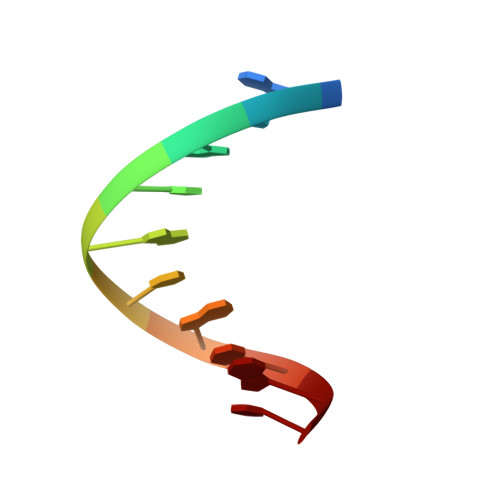Solution structure of [d(GCGTATACGC)]2.
Cheng, J.W., Chou, S.H., Salazar, M., Reid, B.R.(1992) J Mol Biol 228: 118-137
- PubMed: 1447776
- DOI: https://doi.org/10.1016/0022-2836(92)90496-7
- Primary Citation of Related Structures:
1D68 - PubMed Abstract:
The solution structure of the alternating pyrimidine-purine DNA duplex [d(GCGTATACGC)]2 has been determined using two-dimensional nuclear magnetic resonance techniques and distance geometry methods. Backbone distance constraints derived from experimental nuclear Overhauser enhancement and J-coupling torsion angle constraints were required to adequately define the conformation of the inter-residue backbone linkages and to avoid underwinding of the duplex. The distance geometry structures were further refined by back-calculation of the two-dimensional nuclear Overhauser enhancement spectra to correct spin-diffusion distance errors. Fifteen final structures for [d(GCGTATACGC)]2 were generated from the refined experimental distance bounds. These structures all exhibit fully wound B-form geometry with small penalty values (< 1.5 A) against the distance bounds and small pair-wise root-mean-square deviation values (typically 0.6 A to 1.5 A). The final structures exhibit positive base-pair inclination with respect to the helix axis, a marked alternation in rise and twist, and are shorter and wider than classical fiber B-form DNA. The purines were found to adopt a sugar pucker close to the C-2'-endo conformation while pyrimidine sugars exhibited significantly lower pseudorotation phase angles in the C-1'-exo to C-2'-endo range. The minor groove cross-strand steric clashes at pyrimidine-purine steps that would exist in pure B-DNA are attenuated by an increased rise at these steps (and an increased roll angle at TpA steps). Concomitantly the backbone torsion angles of the pyrimidine moieties have larger gamma values, larger epsilon values, and smaller zeta values than the purines. The structures generated by distance geometry methods were also compared with those obtained from restrained molecular dynamics with empirical force-field potentials. The results indicate that the nuclear magnetic resonance/distance geometry approach alone is capable of elucidating most of the salient structural features of double-stranded helical nucleic acids in solution without resorting to empirical energy potentials and without using any structural assumptions from crystallographic data.
Organizational Affiliation:
Chemistry Department, University of Washington, Seattle 98195.













